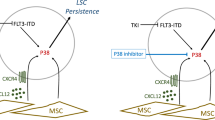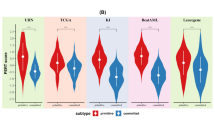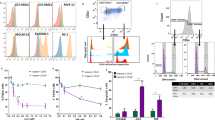Abstract
Relapse in acute myeloid leukaemia (AML) is mediated by survival of leukaemic stem cells following remission-induction chemotherapy. It would therefore be useful to identify therapeutic agents that target leukaemic stem cells. We devised a flow cytometric chemosensitivity assay allowing 48 h culture of leukaemic blasts in a defined microenvironment followed by enumeration of viable CD34+CD38−CD123+ leukaemic stem and progenitor cells (LSPC). The assay was used to investigate the LSPC response to cytosine arabinoside (Ara-C) and to the FLT3 inhibitor AG1296. There was a 3.6-fold increase in Ara-C-treated LSPC survival under defined ‘niche-like’ conditions compared to culture without microenvironmental support. Nine AML samples with internal tandem duplications of FLT3 (FLT3/ITDs) were treated with AG1296. Three samples were very sensitive (>50% kill) and 4 were moderately sensitive (10–50% kill) in bulk suspension culture without microenvironmental support. However, under defined ‘niche-like’ conditions, the survival of LSPC was enhanced rather than inhibited by AG1296 treatment. We conclude that an interaction between LSPC and a defined in vitro microenvironment models a chemoresistant niche. Our data point to a need to investigate more novel chemotherapeutic agents under these stringent conditions to identify agents that may be suitable to target minimal residual disease in AML.
This is a preview of subscription content, access via your institution
Access options
Subscribe to this journal
Receive 12 print issues and online access
$259.00 per year
only $21.58 per issue
Buy this article
- Purchase on Springer Link
- Instant access to full article PDF
Prices may be subject to local taxes which are calculated during checkout





Similar content being viewed by others
References
Gilliland DG, Griffin JD . The roles of FLT3 in hematopoiesis and leukemia. Blood 2002; 100: 1532–1542.
Grimwade D, Walker H, Oliver F, Wheatley K, Harrison C, Harrison G et al. The importance of diagnostic cytogenetics on outcome in AML: analysis of 1, 612 patients entered into the MRC AML 10 trial. The Medical Research Council Adult and Children's Leukaemia Working Parties. Blood 1998; 92: 2322–2333.
Gale RE, Hills R, Kottaridis PD, Srirangan S, Wheatley K, Burnett AK et al. No evidence that FLT3 status should be considered as an indicator for transplantation in acute myeloid leukemia (AML): an analysis of 1135 patients, excluding acute promyelocytic leukemia, from the UK MRC AML10 and 12 trials. Blood 2005; 106: 3658–3665.
Lapidot T, Sirard C, Vormoor J, Murdoch B, Hoang T, Caceres-Cortes J et al. A cell initiating human acute myeloid leukaemia after transplantation into SCID mice. Nature 1994; 367: 645–648.
Bonnet D, Dick JE . Human acute leukemia is organised as a hierarchy that originates from a primitive hematopoietic cell. Nat Med 1997; 3: 730–737.
Hope KJ, Jin L, Dick JE . Acute myeloid leukemia originates from a hierarchy of leukemic stem cell classes that differ in self-renewal capacity. Nat Immunol 2004; 5: 738–743.
Wang JC, Dick JE . Cancer stem cells: lessons from leukemia. Trends Cell Biol 2005; 15: 494–501.
van Rhenen A, Feller N, Kelder A, Westra AH, Rombouts E, Zweegman S et al. High stem cell frequency in acute myeloid leukemia at diagnosis predicts high minimal residual disease and poor survival. Clin Cancer Res 2005; 11: 6520–6527.
Jordan CT, Upchurch D, Szilvassy SJ, Guzman ML, Howard DS, Pettigrew AL et al. The interleukin-3 receptor alpha chain is a unique marker for human acute myelogenous leukemia stem cells. Leukemia 2000; 14: 1777–1784.
Arai F, Hirao A, Suda T . Regulation of hematopoiesis and its interaction with stem cell niches. Int J Hematol 2005; 82: 371–376.
Taichman RS . Blood and bone: two tissues whose fates are intertwined to create the hematopoietic stem-cell niche. Blood 2005; 105: 2631–2639.
Hazlehurst LA, Landowski TH, Dalton WS . Role of the tumor microenvironment in mediating de novo resistance to drugs and physiological mediators of cell death. Oncogene 2003; 22: 7396–7402.
Matsunaga T, Takemoto N, Sato T, Takimoto R, Tanaka I, Fujimi A et al. Interaction between leukemic-cell VLA-4 and stromal fibronectin is a decisive factor for minimal residual disease of acute myelogenous leukemia. Nat Med 2003; 9: 1158–1165.
Steelman LS, Pohnert SC, Shelton JG, Franklin RA, Bertrand FE, McCubrey JA . JAK/STAT, Raf/MEK/ERK, PI3K/Akt and BCR-ABL in cell cycle progression and leukemogenesis. Leukemia 2004; 18: 189–218.
Ailles LE, Gerhard B, Hogge DE . Detection and characterization of primitive malignant and normal progenitors in patients with acute myelogenous leukemia using long-term coculture with supportive feeder layers and cytokines. Blood 1997; 90: 2555–2564.
Guan Y, Hogge DE . Proliferative status of primitive hematopoietic progenitors from patients with acute myelogenous leukemia (AML). Leukemia 2000; 14: 2135–2141.
Sutherland H, Blair A, Vercauteren S, Zapf R . Detection and clinical significance of human acute myeloid leukaemia progenitors capable of long-term proliferation in vitro. Br J Haematol 2001; 114: 296–306.
Hatfield K, Ryningen A, Corbascio M, Bruserud O . Microvascular endothelial cells increase proliferation and inhibit apoptosis of native human acute myelogenous leukemia blasts. Int J Cancer 2006; 119: 2313–2321.
Arai F, Hirao A, Ohmura M, Sato H, Matsuoka S, Takubo K et al. Tie2/angiopoietin-1 signaling regulates hematopoietic stem cell quiescence in the bone marrow niche. Cell 2004; 118: 149–161.
Smith BD, Levis M, Beran M, Giles F, Kantarjian H, Berg K et al. Single-agent CEP-701, a novel FLT3 inhibitor, shows biologic and clinical activity in patients with relapsed or refractory acute myeloid leukemia. Blood 2004; 103: 3669–3676.
Stone RM, DeAngelo DJ, Klimek V, Galinsky I, Estey E, Nimer SD et al. Patients with acute myeloid leukemia and an activating mutation in FLT3 respond to a small-molecule FLT3 tyrosine kinase inhibitor, PKC412. Blood 2005; 105: 54–60.
Levis M, Murphy KM, Pham R, Kim KT, Stine A, Li L et al. Internal tandem duplications of the FLT3 gene are present in leukemia stem cells. Blood 2005; 106: 673–680.
Birkenkamp KU, Geugien M, Lemmink HH, Kruijer W, Vellenga E . Regulation of constitutive STAT5 phosphorylation in acute myeloid leukemia blasts. Leukemia 2001; 15: 1923–1931.
Tse KF, Allebach J, Levis M, Smith BD, Bohmer FD, Small D . Inhibition of the transforming activity of FLT3 internal tandem duplication mutants from AML patients by a tyrosine kinase inhibitor. Leukemia 2002; 16: 2027–2036.
Hunter HM, Pallis M, Seedhouse CH, Grundy M, Gray C, Russell NH . The expression of P-glycoprotein in AML cells with FLT3 internal tandem duplications is associated with reduced apoptosis in response to FLT3 inhibitors. Br J Haematol 2004; 127: 26–33.
Pallis M, Syan J, Russell NH . Flow cytometric chemosensitivity analysis of blasts from patients with acute myeloblastic leukemia and myelodysplastic syndromes: the use of 7AAD with antibodies to CD45 or CD34. Cytometry 1999; 37: 308–313.
Altman D . Practical statistics for medical research. Chapman and Hall: London, 1991, 162pp.
Seedhouse CH, Hunter HM, Lloyd-Lewis B, Massip AM, Pallis M, Carter GI et al. DNA repair contributes to the drug-resistant phenotype of primary acute myeloid leukaemia cells with FLT3 internal tandem duplications and is reversed by the FLT3 inhibitor PKC412. Leukemia 2006; 20: 2130–2136.
van Rhenen A, Moshaver B, Kelder A, Feller N, Nieuwint AW, Zweegman S et al. Aberrant marker expression patterns on the CD34+CD38− stem cell compartment in acute myeloid leukemia allows to distinguish the malignant from the normal stem cell compartment both at diagnosis and in remission. Leukemia 2007; 21: 1700–1707.
Van Der Pol MA, Feller N, Roseboom M, Moshaver B, Westra G, Broxterman HJ et al. Assessment of the normal or leukemic nature of CD34+ cells in acute myeloid leukemia with low percentages of CD34 cells. Haematologica 2003; 88: 983–993.
Ishikawa F, Yoshida S, Saito Y, Hijikata A, Kitamura H, Tanaka S et al. Chemotherapy-resistant human AML stem cells home to and engraft within the bone-marrow endosteal region. Nat Biotechnol 2007; 25: 1315–1321.
Florian S, Sonneck K, Hauswirth AW, Krauth MT, Schernthaner GH, Sperr WR et al. Detection of molecular targets on the surface of CD34+/CD38− stem cells in various myeloid malignancies. Leuk Lymph 2006; 47: 207–222.
Guan Y, Gerhard B, Hogge DE . Detection, isolation and stimulation of quiescent primitive leukemic progenitor cells from patients with acute myeloid leukemia (AML). Blood 2002; 5: 5.
Tao M, Li B, Nayini J, Andrews CB, Huang RW, Devemy E et al. SCF, IL-1beta, IL-1ra and GM-CSF in the bone marrow and serum of normal individuals and of AML and CML patients. Cytokine 2000; 12: 699–707.
Guzman ML, Neering SJ, Upchurch D, Grimes B, Howard DS, Rizzieri DA et al. Nuclear factor-kappaB is constitutively activated in primitive human acute myelogenous leukemia cells. Blood 2001; 98: 2301–2307.
Kottaridis PD, Gale RE, Frew ME, Harrison G, Langabeer SE, Belton AA et al. The presence of a FLT3 internal tandem duplication in patients with acute myeloid leukemia (AML) adds important prognostic information to cytogenetic risk group and response to the first cycle of chemotherapy: analysis of 854 patients from the United Kingdom Medical Research Council AML 10 and 12 trials. Blood 2001; 98: 1752–1759.
Acknowledgements
We thank the NCRN adult working party for the permission to use trial samples. The method of analysis of rare events in flow cytometry was suggested to us by Dr T Hoy, Department of Haematology, University of Cardiff. All research was carried out in the Division of Haematology, University of Nottingham. This study was funded by a project grant from the Leukaemia Research Fund. Ullas Mony was in receipt of an Overseas Research Scholarship.
Author information
Authors and Affiliations
Corresponding author
Rights and permissions
About this article
Cite this article
Mony, U., Jawad, M., Seedhouse, C. et al. Resistance to FLT3 inhibition in an in vitro model of primary AML cells with a stem cell phenotype in a defined microenvironment. Leukemia 22, 1395–1401 (2008). https://doi.org/10.1038/leu.2008.125
Received:
Revised:
Accepted:
Published:
Issue Date:
DOI: https://doi.org/10.1038/leu.2008.125
Keywords
This article is cited by
-
Fabrication of a three-dimensional bone marrow niche-like acute myeloid Leukemia disease model by an automated and controlled process using a robotic multicellular bioprinting system
Biomaterials Research (2023)
-
Activating JAK-mutations confer resistance to FLT3 kinase inhibitors in FLT3-ITD positive AML in vitro and in vivo
Leukemia (2021)
-
Histone deacetylase inhibitor targets CD123/CD47-positive cells and reverse chemoresistance phenotype in acute myeloid leukemia
Leukemia (2019)
-
Serum Exosome MicroRNA as a Minimally-Invasive Early Biomarker of AML
Scientific Reports (2015)
-
SKLB-677, an FLT3 and Wnt/β-catenin signaling inhibitor, displays potent activity in models of FLT3-driven AML
Scientific Reports (2015)



